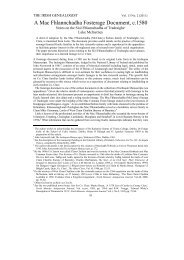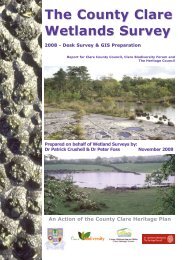Documents from the Thomond Papers at Petworth House Archive1 ...
Documents from the Thomond Papers at Petworth House Archive1 ...
Documents from the Thomond Papers at Petworth House Archive1 ...
Create successful ePaper yourself
Turn your PDF publications into a flip-book with our unique Google optimized e-Paper software.
Archivium Hibernicum<br />
Glenomallun’s lands, as he has been so long away. He would<br />
be ready to transact and agree for his lands upon reasonable<br />
consider<strong>at</strong>ions. 134<br />
This, however, was not to be. Perhaps unsurprisingly considering his<br />
personal networks and distinguished military career, Sir Dermot was in<br />
contact with leading men in Co. Clare regarding foreign military service.<br />
In 1633 Boetius Clanchy, scion of <strong>the</strong> Mac Fhlannchadha lineage <strong>from</strong><br />
Corcomroe wrote to ‘Baron Quirshe of Glenimulloon’ recommending <strong>the</strong><br />
bearer of <strong>the</strong> letter, Rossie O’Loughlin, as a potential recruit for service on<br />
<strong>the</strong> continent. 135 The émigré Irish str<strong>at</strong>egy of advancing military careers in<br />
<strong>the</strong> service of France and Spain was already well established by <strong>the</strong> 1630s and<br />
demand for manpower in Europe was gre<strong>at</strong> due to <strong>the</strong> Thirty Years War.<br />
In 1634, having failed to reach ‘reasonable consider<strong>at</strong>ions’ with Sir<br />
Barnaby O’Brien on <strong>the</strong> purchase of his ancestral lands Sir Dermot, as one<br />
of a handful of MPs of Gaelic stock, was summoned to <strong>at</strong>tend <strong>the</strong> Dublin<br />
parliament. 136 Sir Dermot was unable to <strong>at</strong>tend on account of ill health. 137<br />
Many Irish nobles serving on <strong>the</strong> Continent maintained <strong>the</strong> practice of<br />
keeping genealogies and identified closely with <strong>the</strong>ir Irish lands, irrespective<br />
of decades of service abroad. When Sir Dermot died in 1639 his<br />
epitaph noted th<strong>at</strong> he ‘was exiled when a boy <strong>from</strong> my own country’ and<br />
th<strong>at</strong>, first and foremost, he was ‘Baron de Glenomallun’, his o<strong>the</strong>r titles of<br />
secondary importance. 138<br />
134 Ibid.<br />
135 Calendar of <strong>the</strong> St<strong>at</strong>e <strong>Papers</strong> Rel<strong>at</strong>ing to Ireland, of <strong>the</strong> reign of Charles I, 1633–1647, (London,<br />
1901), p. 18. In a petition by Albert Baron Gleanomalun in 1640, <strong>the</strong> only surviving son of<br />
Sir Dermot, it was st<strong>at</strong>ed th<strong>at</strong> Sir Dermot was active in sending intelligence about England<br />
and Ireland to King Phillip III of Spain in <strong>the</strong> 1610s, and th<strong>at</strong> he ‘caused many men to come<br />
<strong>from</strong> Ireland to <strong>the</strong>se St<strong>at</strong>es; and upon different occasions he drew o<strong>the</strong>rs of his n<strong>at</strong>ion in<br />
gre<strong>at</strong> numbers <strong>from</strong> Holland, by command of <strong>the</strong> Lady Infanta’. Brendan Jennings (ed) Wild<br />
Geese in Spanish Flanders 1582–1700, p.313.<br />
136 Calendar of <strong>the</strong> St<strong>at</strong>e <strong>Papers</strong> Rel<strong>at</strong>ing to Ireland, of <strong>the</strong> reign of Charles I, 1633–1647, pp 18, 59–<br />
60. Wentworth summoned a Parliament in 1633 which lasted until 1635. Initially <strong>the</strong> C<strong>at</strong>holic<br />
interest was plac<strong>at</strong>ed with <strong>the</strong> promises of ‘Graces’ or concessions, but difficulty arose when<br />
<strong>the</strong> conditions of <strong>the</strong> Graces were changed and Parliament passed an act establishing a<br />
Commission for Defective Title under which each land grant made in <strong>the</strong> previous sixty<br />
years was to be examined. Edmund Curtis, A History of Ireland, pp.240–241.<br />
137 See <strong>the</strong> claim of Sir Dermod O’Malun, baron of Gleanomalun, to sit in Irish parliament<br />
and <strong>the</strong> reference <strong>the</strong>rein which st<strong>at</strong>ed: ‘he would if his health did permit’ (The N<strong>at</strong>ional<br />
Archives, Kew, SP 7/25, ff 295, 296). Amongst <strong>the</strong> published papers of <strong>the</strong> Earl of Strafford<br />
is a list of <strong>the</strong> deleg<strong>at</strong>es of <strong>the</strong> 1634 Irish Parliament and th<strong>at</strong> ‘Lord of Glean Molune and<br />
Cuerchy’ was noted as absent. William Knowler, The Earl of Strafforde’s Letters and Disp<strong>at</strong>ches,<br />
with an Essay towards his Life by Sir George Radcliffe: From <strong>the</strong> Originals in <strong>the</strong> Possession of<br />
his Gre<strong>at</strong> Grandson <strong>the</strong> Right Honourable Thomas Earl of Malton, Knight of <strong>the</strong> B<strong>at</strong>h, Vol.1.,<br />
William Bowyer printer (London, 1739) p. 283. As early as 1614 Sir Dermot was described as<br />
‘infirm and in danger of de<strong>at</strong>h on account of his advanced age’. Brendan Jennings (ed.) Wild<br />
Geese in Spanish Flanders 1582–1700, p. 143.<br />
138 Gráinne Henry, The Irish Military Community in Spanish Flanders, 1586–1621, p.86. Sir<br />
30

















